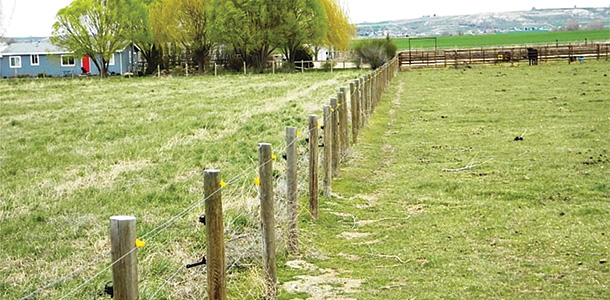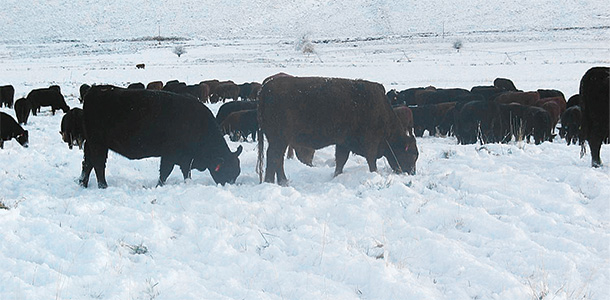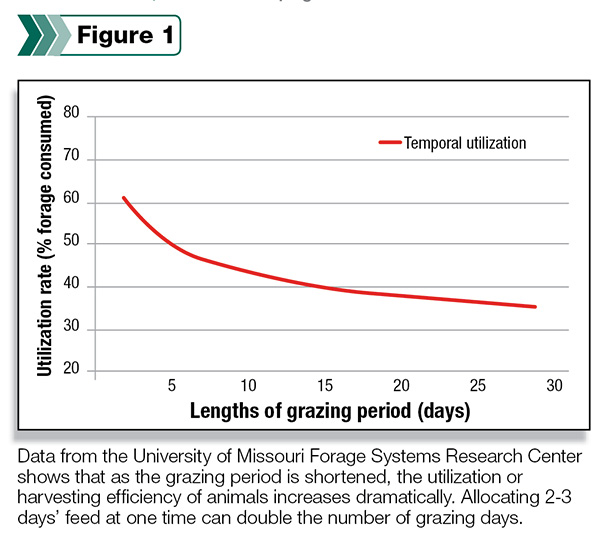Operators also know that winter feeding costs are the largest and most troublesome expense. Our paradigm for reducing winter feeding costs is in terms of manipulating harvested feeds: balancing rations at minimum levels to stretch haystacks, incorporating byproduct feeds, using treated straw, and separating and feeding animals feeds according to their specific nutritional requirements, etc.
But the fastest way to reduce winter feeding cost is to have cattle graze longer … earlier in the spring and longer in the fall. March is not too soon to start thinking about how to make this happen.
Earlier in the spring
It is unlikely that anyone is going to get on the federal grazing leases before the specified date, or drastically affect how soon your home pasture will be ready this spring, but there are things that one can do to make private pasture available for grazing a little sooner.
Residual is the green, living plant material left after grazing. We often think that after our pastures go dormant, there are no consequences to letting the animals completely remove all the material.
Unfortunately, this is not true. Unlike alfalfa, grasses store most of their winter reserve energy for spring growth in the lower 1 to 3 inches of the stem base.
When we permit animals to utilize this material in the fall and early winter, we retard spring growth. Almost everyone has seen this … the roadside area the livestock cannot reach next to a pasture greens up earlier and grows more aggressively than the pasture which was completely denuded in September.

Leaving 3 to 4 inches of residual in the fall is important to get pastures off to a good start in the spring.
New growth in pastures is also very important in making a pasture ready to graze. Everyone has noticed at some point if they are feeding hay on pastures that, as the pasture begins to green up, the animals are less interested in their hay ration and are out “chasing grass.”
Who can blame them? The new shoots are full of sugars and protein, although very little dry matter. They are like candy after a winter of beans and dry beef.
The problem is that this new growth came from the last bits of reserves in the plants after the winter for the purpose of establishing the new solar panel for this year.
Every new shoot we permit the animals to consume holds back the progress of the entire pasture. So if you are feeding on pasture, when the cattle start “chasing grass,” confine them to a “sacrifice area” so that the rest of the pastures can develop a full solar panel as rapidly as possible.
Later in the fall
The growing season and the grazing season do not have to be the same. Using a variety of techniques, it is possible to provide adequate quality forage for livestock they can harvest themselves far into the fall and early winter. By using established perennial crops, the cost can be as little as 25 cents per head per day.
Aftermath
Managing crop aftermath is absolutely the least expensive way of extending the grazing season and lowering winter feeding costs.
Virtually every rancher has some kind of aftermath they permit their livestock to utilize in the fall. Aftermath may also be available on a neighbor’s place.
Cattle can utilize a wide variety of materials from alfalfa hay stubble, corn stover, sugar beet tops, grain stubble or other materials.
Usually these materials are utilized by throwing a fence around them or opening all the gates on the place and letting the cattle eat what they want. With this method, the quality as well as quantity of the aftermath deteriorates every day the cattle have access, reducing quality and consumption.
Controlling access and allocating enough feed for two to three days at a time will usually double grazing days and provides higher-quality forage during the entire time the aftermath is utilized.
Stockpiled perennial crops
Stockpiling is the technique of growing feed during the growing season and allocating it out over the non-growing season.
The easiest and least expensive way to do this is with permanently established perennial crops such as existing pasture and alfalfa.
The first requirement is to have sufficient forage in the pasture at the end of the growing season. While everyone will develop slightly different methods, this is done by stopping grazing or taking the last cutting of hay sometime at the beginning of August, so that there is sufficient time to regrow a significant quantity of feed.
Conditions for growth, water and nutrients must exist. This feed is then allocated to the animals after the growing season.
If animals are permitted to eat whatever they wish, the equivalent of leaving the gate to the stack yard open, they will harvest about 30 to 40 percent of the available material.
If the grazing period is restricted to one to two days, using electric fencing, harvesting efficiency can shoot up to 75 to 80 percent, which means more days of feed, higher-quality feed and lower cost per head.
Some forages, like tall fescue pastures, stockpile well “on the stump,” while others, like alfalfa, do not since the leaves shatter.
Swathing before the crop freezes can preserve the quality and quantity of the more delicate forages, like alfalfa.

Controlling access in swath grazing will preserve quality and increase harvesting efficiency. Once animals realize there is feed under the snow, they will seek it out.
By restricting access to a few days’ feed at a time, the cattle are prevented from making the forage unavailable by packing the feed into the ice.
Range can be stockpiled and used at a non-traditional time that may be beneficial to the vegetation as well as the operator.
Private range can be managed more easily, but public land managers may be interested in changing the season of use as well.
Stockpiled annual crops
Any number of annual crops can be grown for livestock feed and either harvested as hay or by grazing animals.
These include corn, cereals, sorghum sudangrass, pearl millet, turnips, radishes and annual legumes. Some of these can be grown as cover crops to prevent erosion and increase snow deposition, and following grazing the residue incorporated to build soil health.
Read more about these “unconventional” forages in this article from Progressive Cattleman.
Like some perennial forages, quality or access in the field can be improved by swath grazing. Annual forages can preserve flexibility in cropping systems and provide large quantities of good-quality feed.
They provide an alternative that is less expensive than feeding hay but still more costly than the alternatives above.
An annual forage that could be easily overlooked is volunteer cereal plants that are available when we irrigate a field after harvest. Instead of just disking these down, one can graze them first.
A few operators grow corn, specifically for the purpose of overwintering their cattle. In Butte County, Idaho, there is an operator who successfully carries his cattle with virtually no mechanically harvested feed.

Summary
Since the grazing season and the growing season need not be the same, extending the grazing season by leaving adequate fall residue, effectively utilizing aftermath, stockpiling perennial forage crops like fescue or even alfalfa, and growing and grazing annual forages are all ways of significantly reducing winter feeding costs compared to conventional hay feeding.
For all these methods to significantly reduce costs, adequate planning and control of feed allocation are essential. March is not too soon to start thinking about how to lower your winter feeding cost next fall. ![]()
References omitted due to space but are available upon request. Click here to email the editor.
PHOTOS
TOP: Calving cows and calves standing in corn as their winter feed in the Lost River Valley. Photo by Charles Cheyney.
MIDDLE: The Owyhee County pasture on the left was grazed to a residual of 4 inches in the fall, while the pasture on the right was kept “putting green” height most of the winter. The pasture on the left was ready to graze three weeks earlier in the spring than the pasture on the right. Photo by Scott Jensen
BOTTOM: Use swath grazing in areas with higher snow levels or where preserving quality is critical. Swaths can provide 50 to 200 cow-days of grazing per acre, and like other forms of grazing, livestock control and allocation of the forage for one to three days at a time dramatically increases harvesting efficiency. Photo by American GrazingLands Services.
Charles Cheyney
Extension Educator
University of Idaho






